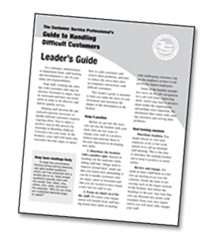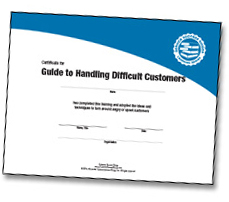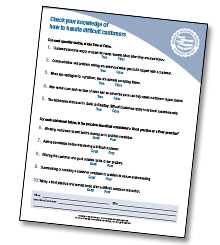Description
Customer Service Training in Working with Difficult, Angry or Upset Customers.
It’s happened to every customer service rep. They answer the phone or say hello and the customer seems angry or upset right from the start. It’s easy to fall into the trap of taking things personally and becoming defensive, angry or intractable in response.
Now, you can help your reps turn those customers around with this four part training tool.
Your package includes 10 copies of the Training Booklet plus downloadable Leader’s Guide, Quizzes and Certificates.
The Training Booklets may be used on their own for self-study or you may conduct more formal training sessions with the Leader’s Guide, Quizzes, and Certificates.
It’s a complete training package for working with difficult, angry, or upset customers.
Training Guide

The Guide to Handling Difficult Customers takes readers through seven steps to transform a dissatisfied customer into a satisfied, loyal, long-term customer who knows your organization can be counted on.
It includes information your reps can use to understand why customers become angry or upset; techniques to calm customers and remain calm themselves; detailed complaint handling techniques including key words and phrases; plus an important section on how to recover from a difficult call and get ready to give the next caller first-class service.
Read the table of contents and sample below to see how much useful information is packed into this brief guide.
TABLE OF CONTENTS
- Keep difficult customers in perspective
- Why do customers become angry or upset?
- Good reasons to get good at handling difficult customers
- Help the customer calm down
- Resolve the problem
- End the difficult call gracefully
- Stay calm yourself
SAMPLE
Keep difficult customers in perspective
It’s happened to everyone who works in customer service. You answer the phone or say hello and the customer is angry right from the start. These customers raise their voices, use abusive language, won’t listen to reason, or are simply rude. It’s very easy to fall into the trap of taking such behavior personally and becoming defensive, angry or inflexible. But it’s your job to take customer calls or work with them in person — all types of customers with all types of attitudes.
The most important thing to remember is that difficult customers are relatively few and far between. It’s just that those unpleasant interactions loom large in our memories.
When you do encounter a customer who is truly angry and upset, there are a series of basic actions you can take to calm the customer, resolve the problem and maintain your own professionalism. These techniques apply when you are working with internal customers (members of your own department or organization) or with external customers (customers outside of your organization).
Leader's Guide

To help you get the most from your training materials, you’ll receive a copy of the Leader’s Guide. It will show you how to introduce the materials to your staff in a positive and motivating way. How to reinforce important points in the Student’s Guide. Plus techniques to keep the message fresh long after the materials have been distributed.
Best of all, you don’t have to be a professional trainer. The Leader’s Guide includes discussion topics, activities, trainer’s tips, and more.
Read the sample below to see how much useful information is packed into a brief section of this Leader’s Guide.
SAMPLE
Activity 2: Empathizing and agreeing
A skill related to apologizing is empathizing and agreeing. As noted in the booklet, this is one of the most powerful ways to calm an angry customer, but it can also be a difficult skill to master. For this activity, you can use the sample “problems” you created for Activity 1, or develop new problems. Write these on a white board or poster board.
Next, ask your team to brainstorm strategies for showing empathy and agreement. Introduce the activity with language such as: “It’s difficult to continue to argue or be upset with someone who understands and agrees with you. If you’ve ever been in this situation, you know how quick and effective it is, so let’s brainstorm how we can show empathy and agreement with each of these statements, all without disparaging the company or a colleague.”
Also keep in mind that apologizing, empathizing, and agreeing can often be wrapped into the same sentence. For example, “I’m so sorry, I had a similar situation myself, and we certainly could have handled this better.” That’s a lot of good stuff in one sentence!
Certificate

Use these certificates to acknowledge significant learning and development, and to provide motivation to put new skills into action.
Certificates may be downloaded, personalized, and printed.
Quiz

A brief quiz is included to ensure that students have retained the most important information and are ready to put it into action.
Quizzes may be downloaded and printed.
Guarantee
Your purchase is guaranteed. If you are not 100% satisfied, please notify us within 15 days of receipt for a full refund.
About the Publisher
The Customer Service Group provides ready-to-use tools for customer service training and frontline motivation including a monthly newsletter, training packages, and Customer Service Week celebration materials.





